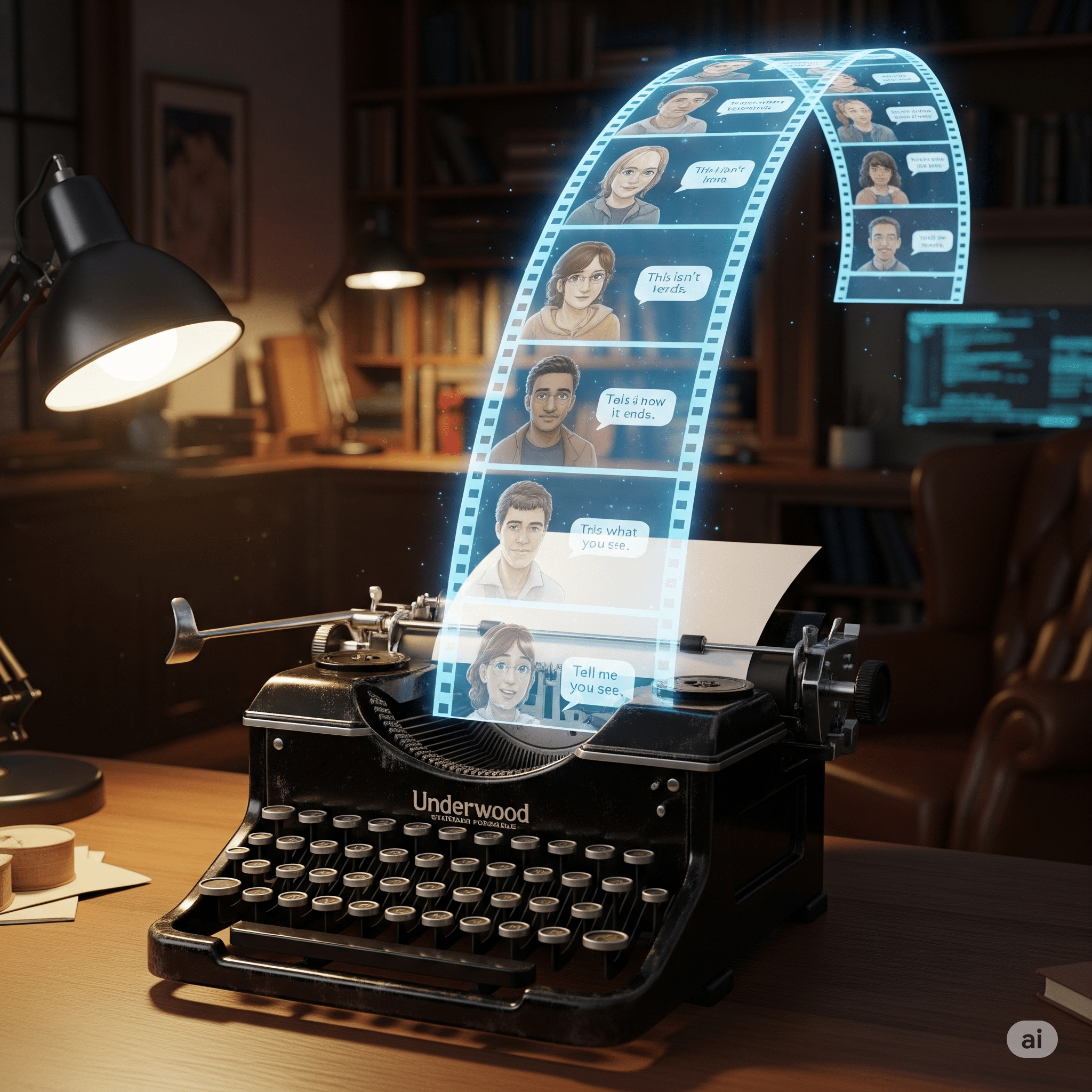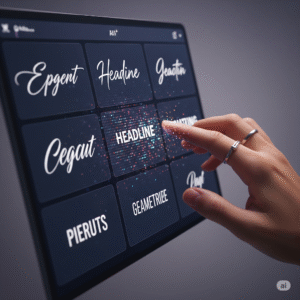The cursor blinks in Final Draft, a relentless metronome counting down to your deadline. The character breakdown is thin, the dialogue feels flat, and the blank page seems to mock you. Every screenwriter, from the aspiring first-timer to the seasoned showrunner, knows this creative trench warfare. It’s the solitary struggle to excavate compelling characters from thin air and make their words crackle with life, subtext, and intention.
For years, the writer’s room, collaboration, and endless cups of coffee were the only remedies. But now, a powerful new ally has entered the scene. Amidst industry-wide debates and legitimate concerns, one thing is becoming clear: AI screenwriting tools are not here to replace the writer, but to become their ultimate assistant. They are the tireless intern who never sleeps, the co-writer who can brainstorm a thousand possibilities in a second, and the dialogue partner who can help you find your character’s true voice.
This guide will move past the headlines and into the practical craft. We’ll explore how you can ethically and effectively use AI screenwriting to conquer the blank page, deepen your characters, and leverage dialogue generation AI to make your script leap off the page. It’s time to see AI not as a competitor, but as the most powerful tool in your creative arsenal.
More Than a Machine: What AI Screenwriting Actually Is (And Isn’t)
The conversation around AI in Hollywood is charged, and for good reason. The idea of a machine “writing” a script strikes at the heart of creative identity. That’s why it is absolutely critical to understand what these tools are truly capable of.
It’s Not a “Script-o-Matic”
Let’s be clear: You cannot give an AI a one-line prompt and expect it to generate a nuanced, emotionally resonant, and production-ready screenplay. AI lacks lived experience, consciousness, and a soul. It doesn’t understand the bittersweet irony of a joke during a funeral or the weight of a character’s unspoken glance. As the Writers Guild of America (WGA) has emphasized, AI is a tool, and the “author” must be human. A script generated entirely by AI would be a hollow echo of stories that have come before, lacking a unique voice or a compelling point of view.
It IS an Un-Sticker, a Brainstormer, and a Dialogue Partner
The true power of AI screenwriting is in collaboration. It’s your partner for breaking through specific, frustrating roadblocks. It’s a tool for generating options, not final decisions. Think of it as a creative sandbox where you can rapidly test ideas without penalty. Stuck on a plot point? The AI can offer ten different paths forward. Character feeling a bit generic? The AI can help you brainstorm a unique backstory or a fatal flaw. This approach keeps you, the writer, firmly in the driver’s seat, using the AI to expand your own creativity.
Building Believable Characters with AI Screenwriting
Great scripts are built on the foundation of unforgettable characters. Before you can write compelling dialogue, you need to know who is speaking. This is where AI screenwriting can be an incredible development tool, helping you move beyond surface-level traits to unearth deep, authentic characters.
You can use AI to:
- Create Detailed Backstories: Give the AI a basic character sketch and ask it to generate a detailed backstory. Prompt it with questions like, “Generate a backstory for a cynical detective who lost her partner. What was their last conversation? What secret guilt does she carry?”
- Explore Motivations and Flaws: A character’s wants and needs drive the story. Use the AI to explore these. “My hero wants to save his family business. What are three moral compromises he might have to make? What is his greatest fear, and how can the villain exploit it?”
- “Interview” Your Characters: This is a powerful technique. Use a tool like ChatGPT to “speak” to your character. Prompt the AI to “act as a jaded space pilot who has seen too much” and then ask it questions. Its responses can reveal surprising details about its personality, worldview, and, most importantly, its unique voice.
The Art of the Spoken Word: Using Dialogue Generation AI
Nothing sinks a script faster than clunky, on-the-nose dialogue. Great dialogue is a dance of subtext, rhythm, and character. A dedicated dialogue generation AI can be an incredible sparring partner to help you sharpen every line.
Finding Your Character’s Voice with Dialogue Generation AI
Once you have a sense of your character, you can use a dialogue generation AI to hone their specific voice. Feed the AI your character’s profile (e.g., “A fast-talking, optimistic tech entrepreneur who uses too much jargon”) and a scenario. Ask it to generate five different ways they might pitch their product. By seeing multiple options, you can cherry-pick the lines and rhythms that feel most authentic, creating a distinct and memorable voice.
Crafting Subtext and Pacing with AI Screenwriting
The golden rule of screenwriting is “show, don’t tell.” This is especially true for dialogue. Instead of prompting an AI to “write a sad scene,” you can get much better results by prompting for subtext. For example: “Write a short scene where a husband and wife discuss dinner plans, but the subtext is that they are both thinking about their recent argument. Don’t mention the argument directly.” The AI is surprisingly adept at generating dialogue that is polite on the surface but simmering with unspoken tension underneath, providing excellent raw material for a powerful scene.
Case Studies: AI Screenwriting on the Front Lines
Let’s look at how working writers can integrate these tools into their professional lives.
Case Study 1: Javier, the TV Writer
The Challenge: Javier works in a fast-paced TV writers’ room. After a long brainstorming session, the showrunner assigns him a scene to write but asks him to come back with three different versions of the ending by the next morning.
The AI Solution: Javier writes the first version of the scene himself. Then, he uses an AI screenwriting tool to explore alternatives quickly. He inputs the scene context and asks the AI to “propose three different cliffhangers for this scene” and “rewrite the final two lines of dialogue to show the protagonist is lying.”
The Result: In under an hour, Javier has a dozen compelling ideas and dialogue snippets. He uses these to craft two more distinct, high-quality endings. He walks into the writers’ room the next day fully prepared, not only with his own vision but with several well-developed alternatives, making him an invaluable and efficient contributor to the team.
Case Study 2: Priya, the Indie Filmmaker
The Challenge: Priya has a brilliant, character-driven script for her first feature film, but her producer says the script is “too quiet” and needs more external conflict to be marketable. Priya is struggling to add stakes without losing the heart of her story.
The AI Solution: Priya uses an AI tool to brainstorm external conflicts that align with her character’s internal journey. She prompts it: “My character’s internal conflict is her fear of commitment. Generate five external plot events that would force her to confront this fear.”
The Result: The AI suggests ideas ranging from a surprise inheritance with a marriage clause to an old flame returning to town with a child. One idea—that her non-committal character must become the legal guardian of her niece—sparks a new vision for Priya. She uses this concept to weave in a new subplot that raises the stakes and externalizes the theme of her film, making the script stronger and more commercially viable without sacrificing its emotional core. This is advanced AI screenwriting at its best.
A Screenwriter’s Workflow for AI Screenwriting
Integrating AI into your craft is a process. Here is a simple, five-step workflow:
- The Logline & “What If?”: Start with your core idea. Feed your logline to the AI and ask it to generate ten “what if” questions to complicate it. This expands your story’s potential from the very beginning.
- Character Interviews: Before writing, conduct in-depth “interviews” with your main characters using an AI chatbot. Discover their secrets, their speech patterns, and their worldview.
- Scene-by-Scene Outlining: Use the AI to help you beat out your story. Give it a beat—”The hero discovers the clue”—and ask it to generate three ways the scene could play out. Assemble the best options into a solid outline.
- Dialogue Sparring Sessions: When you get to a dialogue scene, write a version yourself. Then, ask a dialogue generation AI for three other variations. Compare them. What works? What doesn’t? Use the best bits to refine your original.
- The Human Polish: This is the most crucial step. AI provides the rough clay. Your job is to perform the final, human polish. You must check the rhythm, ensure consistency, layer in your unique voice, and cut anything that doesn’t serve the story.
- Your Next Plot Twist is One Click Away: The Guide to AI Storytelling
The Modern Screenwriter’s Toolkit: Essential AI Platforms
A new suite of powerful tools is available to aid your AI screenwriting process.
- ChatGPT: The indispensable all-rounder. Perfect for brainstorming, outlining, character development, and generating first-draft dialogue snippets.
- Sudowrite: While built for prose, its “Brainstorm,” “Twist,” and “Describe” features are incredibly powerful for screenwriters looking to develop ideas and add cinematic detail.
- AI-Integrated Screenwriting Software: Keep an eye on industry-standard software like Arc Studio Pro and WriterDuet, which are beginning to roll out integrated AI features to assist with formatting and ideation directly within their platforms.
Conclusion: The Writer’s Room in Your Computer
AI screenwriting is not an abdication of creativity; it is a profound enhancement of it. It’s about automating the grunt work of ideation so you can focus on the art of storytelling. It’s about having an infinite number of collaborators to help you find the single best version of your story. The technology is here, and it’s powerful. The writers who learn to partner with it will be the ones who can create richer characters, craft sharper dialogue, and conquer the blank page faster than ever before. The final script, the credit, and the creative soul of the story will always be yours, but you no longer have to find it alone.
Beat Writer’s Block Forever: The Ultimate Guide to AI Creative Writing



